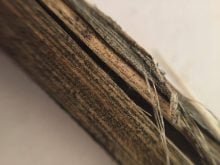Dan Orchard has a blunt message for Saskatchewan canola producers.
“I’m quite convinced that clubroot will come to your farm. It’s just too hard to keep it away,” said Orchard, agronomy specialist for central Alberta for the Canola Council of Canada. Orchard was speaking at the Saskatchewan Oilseed Producers meeting, organized by SaskCanola, SaskFlax, and the Sask. government, at North Battleford on November 17.
The stakes are high for many farmers. The worst-case clubroot scenario is that a farmer won’t be able to grow canola economically in a heavily infested field. Orchard has visited five such fields in Alberta.
Read Also

Claas brings 1000 Series SP forage harvesters to Canada
In mid-August, Claas unveiled its new line of Jaguar forage harvesters at an event in Visalia, California, deep in the heart of that state’s dairy region.
“Clubroot has defeated the resistance of the resistant varieties,” said Orchard.
Kent Lamoureux, senior agronomist for Sturgeon Valley Fertilizers, said their local term for fields with very high spore loads is a Ground Zero field. Lamoureux relayed his experience with clubroot at an agronomy day organized by Cavalier Agrow in northwest Saskatchewan.
Lamoureux credited Orchard for first finding the disease in Alberta in 2003. It was discovered in a vegetable production area in Sturgeon County, just north of Edmonton, he said. Orchard was an agronomist with Sturgeon Valley Fertilizers at the time.
Since then, agronomists’ and farmers’ experience with the disease “has been nothing short of an odyssey,” said Lamoureux.
And just as Odysseus endured terrible losses on his long journey home after the Trojan war, Sturgeon County farmers have also seen some bad times. Even Lamoureux’s family farm has been affected by clubroot, he said.
Still, farmers needn’t throw up their hands in despair. The key is to keep spore loads low and find infestations early, Orchard said.
A gram of soil can hold up to a billion clubroot spores. Lamoureux said Ground Zero fields, which can’t even grow resistant varieties, have about ten million spores or more per gram. He said it would take about 100,000 spores per gram to cause an infection in the crop.
But infested fields in Manitoba and Saskatchewan are more likely to have around 50,000 spores per gram, said Orchard. “And we would call that really, really low in Alberta,” said Orchard.
That lower spore load gives Saskatchewan and Manitoba farmers more options for managing the disease. Manitoba and Saskatchewan farmers also have more technology and knowledge to draw on than their Alberta counterparts did when the disease first emerged.
Start looking
If Lamoureux could go back in time, he would set up an intelligent clubroot scouting program, he said.
A clubroot-infected crop patch might display relatively subtle symptoms, such as ripening a bit early, having a thinner plant stand, or having plants that are an off-green/yellow colour. Lamoureux said the disease can look a little like sclerotinia, but clubroot creates a creamier colour.

By that point, the clubroot may have been present for several canola crops, said Orchard. The lack of above-ground symptoms in the early years of the disease can deter farmers from scouting.
“But I’m here to tell you that you need to start pulling plants at the entrance,” said Orchard.
Crops generally look poor at the field entrance, so farmers tend to ignore early signs of the disease. But Orchard said clubroot infestations usually start at the field entrance, and to the right of the field entrance.
Over the years, Orchard has found clubroot in other places, too. Old garden sites from homesteads can be an infestation source, as some vegetables host the disease. Other areas include alternate field entrances, farmyards, downwind of grain bins, highway exits, near beehives, near power lines, and low areas or areas with water.
Lamoureux also suggested farmers check persistently weedy patches and lease roads. He’s also seen a clubroot patch form where the combine broke down and was partly disassembled. The combine dust spawned the infestation.
It’s possible to test soil for clubroot. Orchard cautioned that a negative result doesn’t guarantee the field is clubroot-free. It might mean that producers sampled the wrong spot in the field. But farmers who do want to test soil for clubroot should sample from the area just to the right of the field entrance, he said.
Lamoureux suggested starting scouting four weeks before swathing, as visual symptoms will be the most obvious. Farmers who notice canola plants flipping up and landing on the canvas while swathing should be wary. Those plants might have been infected by clubroot, Lamoureux said, as the disease destroys the roots.
Minimize the spread
Farmers who have fields with infestations in one part of the field have more options than those with fenceline-to-fenceline infestations. One option is to create a separate field exit, far from the entrance, Orchard said. Farmers should not use the new exit as an entrance/exit. By having a dedicated exit, a farmer can reduce the chances carrying clubroot from that field.
Farmers can also seed the area around the entrance to a non-host crop, such as perennial ryegrass.
“I think there are so many benefits to putting a small grassed area at the entrance,” said Orchard. A grassy entrance cuts the chances of spores spreading through the field. It also gives operators an area to park, unfold, and clean equipment, he added.
Sanitizing equipment between fields has not been a popular suggestion in Alberta. Orchard acknowledged it’s not practical to do at seeding time. And given the heavy spore loads in central Alberta fields, operators would have to be very thorough to prevent disease spread.
But farmers facing lower spore loads don’t have to be nearly as thorough to make a difference. Orchard said knocking off basketball-sized lumps of dirt would go a long way in Saskatchewan.
Farm machinery isn’t the only equipment that can spread clubroot. Equipment from road crews can spread spores, so farmers may want to think twice before letting others park equipment in fields. And while machinery is the main culprit in spreading clubroot, it’s not the only one. Muddy boots can carry up to 600,000 spores per gram, according to research Orchard has read.
Lamoureux said they’ve stopped mud-slinging in his area. They don’t float fertilizer or sample soil if it’s muddy, and they clean dirt off equipment. Farmers also seed Ground Zero fields last, giving the field a chance to dry out and minimizing the spread to other fields.
Dust is dangerous too, Lamoureux added. Research has found dust from Ground Zero fields was “loaded with clubroot,” he says. “Think about your harvest.”
Lamoureux advised farmers to treat seed to ensure that it’s not carrying clubroot. Random sampling at a seed cleaning plant in a heavily infested clubroot area found that soil on seeds can bear the disease as well. Once the seed is commercially cleaned and treated, it won’t carry clubroot, Orchard said. He advised against getting common, untreated seed from known clubroot areas.
The disease can also survive a cow’s digestive system, Orchard said. Farmers shouldn’t spread manure over crop fields from cattle that have eaten a clubroot-ravaged crop.
Control weeds
Canola isn’t the only potential clubroot host in farmers’ fields. Weed hosts include stinkweed, shepherd’s purse, wild mustard, and volunteer canola.
“Control volunteer canola religiously,” said Lamoureux.
Both Orchard and Lamoureux advised farmers to control those weeds, whether or not canola is being grown in that field that year. Weeds will produce viable clubroot spores within weeks of germinating, so farmers should spray at the two or three-leaf stage, Orchard added.
Use resistant varieties
Clubroot-resistant varieties are like relief pitchers in baseball, said Orchard.
“You have to put your relief pitcher in one pitch before the grand slam, not one pitch after.”
Some farmers, thinking the infestation isn’t that bad, have stuck with susceptible canola varieties. There’s a perception that clubroot-resistant varieties don’t yield as well as their susceptible kin.
But both Lamoureux and Orchard said there was no yield penalty with the resistant varieties. “And it will prolong your canola-growing situation,” said Lamoureux.
Sticking to a susceptible variety has led to some disastrously low yields in clubroot-infested fields. Orchard advised farmers to start using clubroot-resistant varieties as soon as clubroot is detected in a field, no matter how mild the symptoms initially seem. And the Canola Council advises farmers in clubroot-infested areas to stick to resistant varieties as a precaution.
But farmers shouldn’t rely on resistant varieties alone. Short rotations increase the spore load in a field, giving the local clubroot population a better shot at evolving to overcome those resistant varieties.
So far, 17 clubroot strains have been identified in Alberta. And 11 can’t be controlled by clubroot-resistant canola varieties, said Orchard.
Ultimately, clubroot is a self-limiting disease, said Lamoureux. “Ground Zero fields should not grow canola again.”
Stretch the rotation
Recent research has shown that with a two-year break, 95 to 99 per cent of the clubroot spores aren’t viable, says Orchard.
Unfortunately, for many Alberta farmers spore loads are so high that even a two-year break leaves enough spores to cause a wreck. But Saskatchewan and Manitoba farmers still have a chance to manage the disease through rotation, Orchard said.
Rotation is key, Lamoureux said. Sturgeon Valley Fertilizers has been holding alternative crop workshops to encourage more diverse rotations. Faba beans are now well established in the area, Lamoureux said.
So how long should a farmer’s rotation be? The easy answer is four years, Orchard says.
But defaulting to four years is a little like telling someone you don’t know how fast they should be driving, over the phone, without asking questions, Orchard says. How long a rotation should be depends on everything from a farmer’s experience to disease levels in the area.
The two-year canola rotation has been working for years on the Prairies, Orchard acknowledged. “But not when it comes to clubroot. It needs that extra break.”
Life after clubroot
Losing the ability to grow the most profitable crop is very emotional for farmers. Lamoureux said it causes a lot of turmoil, anger and blaming. He noticed a pattern in his area after clubroot was detected, and every area that followed.
Lamoureux suggested having a bit of psychology in one’s back pocket to deal with clubroot in a mature, intelligent way. He compared discovering clubroot on one’s farm to the seven steps in the grieving process:
- Shock and denial — for example, doubting the accuracy of tested samples.
- Pain and guilt, perhaps over tight rotations.
- Anger, blame and bargaining. Blaming custom applicators, oil crews, or others for bringing it into the field.
- Depression, reflection, loneliness. Perhaps not wanting to go for to the coffee shop because of shame, or not wanting to talk about it.
- The upward turn. Looking at resistant varieties, looking at other crops.
- Reconstruction and working through it. Getting a plan together, adapting cultural practices.
- Acceptance and hope.
Clubroot is not the first challenge farmers have faced. Lamoureux relayed the story of the boll weevil in Alabama. In the early 20th Century, it destroyed cotton crops. The pest forced farmers to change by adding peanuts to their crop rotations. That led to prosperity, and the people of Enterprise, Alabama, installed a boll weevil statue commemorating the insect and the change it wrought.
Is clubroot Alberta’s boll weevil? It doesn’t feel that way right now, Lamoureux said. “But with every crisis there can be an opportunity. So try to embrace this for what it is.”
And ultimately, farming continues in Sturgeon County. Lamoureux said he had some “fantastic” canola yields this year, and he also had some great faba bean yields.
“Think rotation. Think scouting.” And push agronomists to be aware of clubroot, Lamoureux told farmers.
“Don’t panic. Plan.”
















